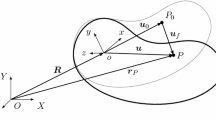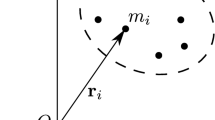Abstract
Different inertia representations can lead to different formulations of the differential-algebraic equations for the quaternion-based rigid body dynamics. In this paper, the inertia representations are classified into \(\alpha \)-type and \(\gamma \)-type, according to the additional parameters in the kinetic energy. These two types of representations and the corresponding parameters \(\alpha \) and \(\gamma \) are theoretically equivalent if the constraint \(\boldsymbol{q}^{T}\boldsymbol{q} = 1\) is satisfied exactly. Nevertheless, the error estimation demonstrates that they can present entirely different numerical features in simulation and suggests that the parameter \(\gamma \) can be used to optimize the numerical performance of the integrations in simulation. To further verify the numerical difference between the inertia representations of \(\alpha \)-type and \(\gamma \)-type, the corresponding modified Hamilton’s equations are discretized by the IMS (implicit midpoint scheme), EMS (energy–momentum preserving scheme) and Gauss–Lobatto SPARK methods. Numerical performance for the examples of the spinning symmetrical top is shown to result from the comprehensive effect of the discretization schemes including the distribution of discretized points and the convergence order, the inertia representations and their combinations. Numerical results further suggest that the integrations of \(\gamma \)-type are superior to those of \(\alpha \)-type and the optimized values of \(\gamma \) can be used to achieve better numerical accuracy, convergence speed and stability.
















Similar content being viewed by others
References
Goldstein, H., Poole, C.P., Safko, J.L.: Classical Mechanics, 3rd edn. Addison–Wesley, New York (2001)
Nikravesh, P.E., Chung, I.S.: Application of Euler parameters to the dynamic analysis of three-dimensional constrained mechanical systems. J. Mech. Des. 104, 785–791 (1982)
Nikravesh, P.E., Kwon, O.K., Wehage, R.A.: Euler parameters in computational kinematics and dynamics, part 2. J. Mech. Transm. Autom. Des. 107, 366–369 (1985)
Nikravesh, P.E.: Computer-Aided Analysis of Mechanical Systems. Prentice-Hall, New York (1988)
Haug, E.J.: Computer Aided Kinematics and Dynamics of Mechanical Systems, vol. 1: Basic Methods. Allyn and Bacon, Boston (1989)
Vadali, S.R.: On the Euler parameter constraint. J. Astronaut. Sci. 36, 259–265 (1988)
Chou, J.C.K.: Quaternion kinematic and dynamic differential equations. IEEE Trans. Robot. Autom. 8, 53–64 (1992)
Morton, H.S. Jr.: Hamiltonian and Lagrangian formulations of rigid-body rotational dynamics based on the Euler parameters. J. Astronaut. Sci. 41, 569–591 (1993)
Shivarama, R., Fahrenthold, E.P.: Hamilton’s equations with Euler parameters for rigid body dynamics modeling. ASME J. Dyn. Syst. Meas. Control-Trans. 126, 124–130 (2004)
Sherif, K., Nachbagauer, K., Steiner, W.: On the rotational equations of motion in rigid body dynamics when using Euler parameters. Nonlinear Dyn. 81, 343–352 (2015)
Betsch, P., Siebert, R.: Rigid body dynamics in terms of quaternions: Hamiltonian formulation and conserving numerical integration. Int. J. Numer. Methods Eng. 79, 444–473 (2009)
Moller, M., Glocker, C.: Rigid body dynamics with a scalable body, quaternions and perfect constraints. Multibody Syst. Dyn. 27, 437–454 (2012)
O’Reilly, O.M., Varadi, P.C.: Hoberman’s sphere, Euler parameters and Lagrange’s equations. J. Elast. 56, 171–180 (1999)
Udwadia, F.E., Schutte, A.D.: An alternative derivation of the quaternion equations of motion for rigid-body rotational dynamics. ASME J. Appl. Mech.-Trans. 77, 4 (2010)
Miller, T.F., Eleftheriou, M., Pattnaik, P., Ndirango, A., Newns, D., Martyna, G.J.: Symplectic quaternion scheme for biophysical molecular dynamics. J. Chem. Phys. 116, 8649–8659 (2002)
Nielsen, M.B., Krenk, S.: Conservative integration of rigid body motion by quaternion parameters with implicit constraints. Int. J. Numer. Methods Eng. 92, 734–752 (2012)
Simo, J.C., Wong, K.K.: Unconditionally stable algorithms for rigid body dynamics that exactly preserve energy and momentum. Int. J. Numer. Methods Eng. 31, 19–52 (1991)
Wendlandt, J.M., Marsden, J.E.: Mechanical integrators derived from a discrete variational principle. Physica D 106, 223–246 (1997)
Manchester, Z.R., Peck, M.A.: Quaternion variational integrators for spacecraft dynamics. J. Guid. Control Dyn. 39, 69–76 (2016)
Leitz, T., Leyendecker, S.: Galerkin Lie-group variational integrators based on unit quaternion interpolation. Comput. Methods Appl. Mech. Eng. 338, 333–361 (2018)
Shabana, A.A.: Euler parameters kinetic singularity. Proc. Inst. Mech. Eng., Proc., Part K, J. Multi-Body Dyn. 228, 307–313 (2014)
Celledoni, E., Safstrom, N.: A Hamiltonian and multi-Hamiltonian formulation of a rod model using quaternions. Comput. Methods Appl. Mech. Eng. 199, 2813–2819 (2010)
Xu, X.M., Zhong, W.X.: On the numerical influences of inertia representation for rigid body dynamics in terms of unit quaternion. ASME J. Appl. Mech.-Trans. 83, 11 (2016)
Jay, L.O.: Specialized partitioned additive Runge–Kutta methods for systems of overdetermined DAEs with holonomic constraints. SIAM J. Numer. Anal. 45, 1814–1842 (2007)
Hairer, E., Lubich, C., Wanner, G.: Geometric Numerical Integration. Structure-Preserving Algorithms for Ordinary Differential Equations, 2nd edn. (2006)
Krenk, S., Nielsen, M.B.: Conservative rigid body dynamics by convected base vectors with implicit constraints. Comput. Methods Appl. Mech. Eng. 269, 437–453 (2014)
Gonzalez, O.: Exact energy and momentum conserving algorithms for general models in nonlinear elasticity. Comput. Methods Appl. Mech. Eng. 190, 1763–1783 (2000)
Small, S.J.: Runge–Kutta Type Methods for Differential-Algebraic Equations in Mechanics. Dissertations & Theses – Gradworks (2011)
Jay, L.: Symplectic partitioned Runge–Kutta methods for constrained Hamiltonian systems. SIAM J. Numer. Anal. 33, 368–387 (1996)
Acknowledgements
The authors are grateful for the support of the Natural Science Foundation of China (grant Nos. 91748203 and 11432010) and the valuable discussion of Dr. Teng Zhang.
Author information
Authors and Affiliations
Corresponding author
Ethics declarations
Disclosure of potential conflicts of interest
Conflict of Interest: The authors declare that they have no conflict of interest.
Additional information
Publisher’s Note
Springer Nature remains neutral with regard to jurisdictional claims in published maps and institutional affiliations.
Appendices
Appendix A: The Gauss SPARK methods in unified form
1.1 A.1 A unified formulation of SPARK methods
In Sect. 4.2.1, we present two types of Gauss SPARK methods based on the discontinuous collocation type methods. It is more efficient in computation to derive a unified formulation of SPARK methods in which the discretization schemes are formulated with Butcher style tableaux of SPARK coefficients.
One step of an (\(s\), \(p\))-SPARK method applied to the Hamiltonian system of (12) with consistent initial values (\(\boldsymbol{q}_{k}\), \(\boldsymbol{p}_{k}\)) at \(t_{k}\) and step-size \(\Delta t\) is given as follows [24, 28]:
where \(\varLambda _{i}\) for \(i = 0, 1,\ldots,p\) is the Lagrange multiplier. \(\boldsymbol{Q}_{i}\), \(\tilde{\boldsymbol{Q}}_{i}\) and \(\boldsymbol{P} _{i}\) denote quantities discretized as the inner points, defined by
The coefficients \((b_{j},c_{j})_{j = 1}^{s}\) and \((\tilde{b}_{j}, \tilde{c}_{j})_{j = 0}^{p}\) are generally two distinct quadrature formulas and the SPARK coefficients can be expressed in the form of Butcher style tableaux:
To ensure the existence and uniqueness of the SPARK solution [24, 28], we should assume \(\bar{a}_{0j} = 0\) and \(\bar{a}_{pj} = b_{j}\) for \(j = 1,\ldots,s\), which imply that \(\tilde{\boldsymbol{Q}}_{0} = \boldsymbol{q}_{k}\) and \(\tilde{\boldsymbol{Q}}_{p} = \boldsymbol{q} _{k + 1}\). Hence Eqs. (A.2), (A.4) and (A.6) give \(p+1\) independent constraints to solve \(p + 1\) Lagrange’s multipliers (i.e., \(\varLambda _{i}\), \(i = 0,\ldots,p\)).
We are especially interested in the SPARK methods whose coefficients are the weights and nodes of Gauss quadrature, to have an optimal order of convergence. The Gauss SPARK coefficients satisfy the following conditions [24, 28]:
and
The two types of Gauss SPARK methods concerned in this paper can be obtained by the following conditions.
s-stage Lobatto IIIA-B method
Let\(p = s - 1\), \(\bar{a}_{(i - 1)j} = a_{ij}\), \(\tilde{a} _{i(j - 1)} = \hat{a}_{ij}\), \(b_{j} = \hat{b}_{j} = \tilde{b}_{j - 1}\), \(\tilde{c}_{i - 1} = c_{i}\), for\(i = 1,\ldots,s\), \(j = 1,\ldots,s\), and\(c_{1},\ldots ,c_{s}\), be the s nodes of the Lobatto quadrature. The Lobatto IIIA-B SPARK method is defined with the coefficients\(a_{ij}\), \(b_{j}\)and\(\hat{a}_{ij}\)determined by
and
with the conditions\(B(s)\), \(C(s)\)and\(\hat{C}(s)\)defined by (A.8) and (A.9).
s-stage Gauss Lobatto method
Let\(p = s\), \(\hat{a}_{ij} = a_{ij}\), \(b_{j} = \hat{b}_{j}\), for\(i = 1,\ldots,s\), and\(c_{1},\ldots ,c_{s}\)be the s nodes of the Gauss quadrature and\(\tilde{c}_{1}, \ldots ,\tilde{c}_{s}\)be the\(s+1\)nodes of the Lobatto quadrature. The Gauss–Lobatto SPARK method is defined with the coefficients\(a_{ij}\), \(b_{j}\), \(\tilde{a}_{ij}\), \(\tilde{b}_{i}\)and\(\bar{a}_{ij}\), determined by
and
with the conditions\(B(s)\), \(C(s)\), \(\tilde{B}(p)\), \(\tilde{C}(p)\)and\(\bar{C}(s)\)defined by (A.8)–(A.12).
1.2 A.2 Butcher style tableaux of Gauss SPARK coefficients
SPARK coefficients can be calculated by substituting nodes of quadrature and the solution conditions presented by Lobatto IIIA-B or Gauss–Lobatto SPARK methods into (A.8)–(A.12). The Lobatto nodes of quadrature \(c_{1},c_{2},\ldots ,c_{s}\) are the zeros of
The Gauss nodes of quadrature \(c_{1},c_{2},\ldots ,c_{s}\) are the zeros of the \(s\)th shifted Legendre polynomial
1.2.1 A.2.1 SPARK coefficients for s-stage -Lobatto IIIA-B SPARK methods
The 2-stage and 3-stage Lobatto IIIA-B SPARK methods correspond to the following Butcher style tableaux of SPARK coefficients:
and
1.2.2 A.2.2 SPARK coefficients for s-stage Gauss–Lobatto SPARK methods
The 1-stage and 2-stage Gauss–Lobatto SPARK methods correspond to the following Butcher style tableaux of SPARK coefficients:
and
Appendix B: Algorithms in pseudocode formats
2.1 B.3 Implicit midpoint scheme and energy–momentum conserving scheme
The implicit midpoint scheme and the energy–momentum conserving scheme presented by (53) and (61) can be summarized in pseudocode format in Table 15.
2.2 B.4 Gauss SPARK methods
Consider the SPARK method presented by (A.1)–(A.6). We can define the residual vectors in the following form:
where \(\boldsymbol{Q}_{i}\), \(\boldsymbol{P}_{i}\) and \(\tilde{\boldsymbol{Q}}_{i}\) are defined by (A.7) and \(\tilde{\boldsymbol{k}}_{i} = - g_{\boldsymbol{q}}( \tilde{\boldsymbol{Q}}_{i})\varLambda _{i}\). Define the unknowns as
Then the Gauss SPARK methods can be summarized uniformly in pseudocode format as in Table 16.
Rights and permissions
About this article
Cite this article
Xu, X., Luo, J. & Wu, Z. The numerical influence of additional parameters of inertia representations for quaternion-based rigid body dynamics. Multibody Syst Dyn 49, 237–270 (2020). https://doi.org/10.1007/s11044-019-09697-x
Received:
Accepted:
Published:
Issue Date:
DOI: https://doi.org/10.1007/s11044-019-09697-x




